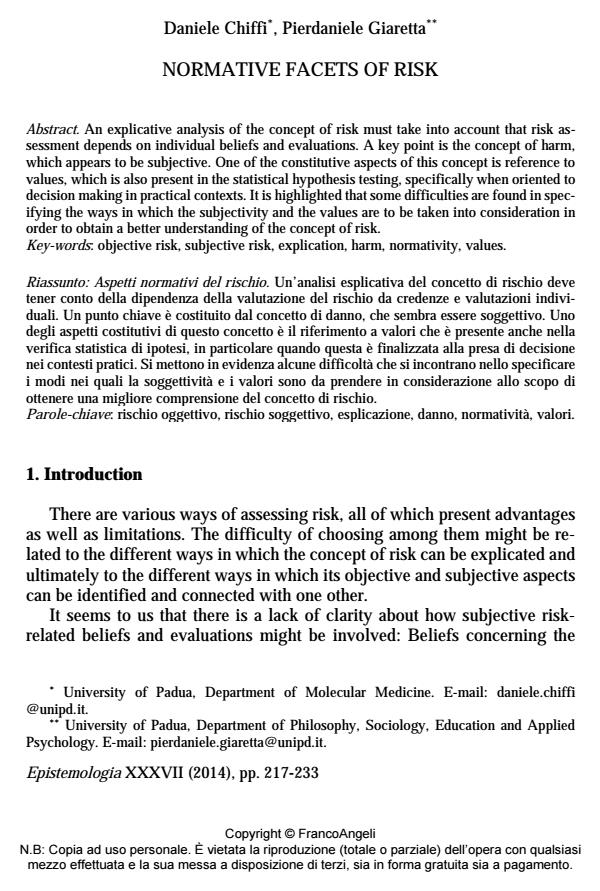Normative facets of risk
Journal title EPISTEMOLOGIA
Author/s Daniele Chiffi, Pierdaniele Giaretta
Publishing Year 2015 Issue 2014/2 Language English
Pages 17 P. 217-233 File size 95 KB
DOI 10.3280/EPIS2014-002003
DOI is like a bar code for intellectual property: to have more infomation
click here
Below, you can see the article first page
If you want to buy this article in PDF format, you can do it, following the instructions to buy download credits

FrancoAngeli is member of Publishers International Linking Association, Inc (PILA), a not-for-profit association which run the CrossRef service enabling links to and from online scholarly content.
An explicative analysis of the concept of risk must take into account that risk assessment depends on individual beliefs and evaluations. A key point is the concept of harm, which appears to be subjective. One of the constitutive aspects of this concept is reference to values, which is also present in the statistical hypothesis testing, specifically when oriented to decision making in practical contexts. It is highlighted that some difficulties are found in specifying the ways in which the subjectivity and the values are to be taken into consideration in order to obtain a better understanding of the concept of risk.
Keywords: Objective risk, subjective risk, explication, harm, normativity, values
- Campbell S. (2007). Risk and the Subjectivity of Preference, Journal of Risk Research, 9(3), pp. 225-242.
- Canguilhem G. (1966). Le normal et le pathologique, Paris, PUF.
- Carnap R. (1950). Logical Foundations of Probability, Chicago, University of Chicago Press.
- Carnap R. (1963). Replies and Systematic Expositions. In Schilpp P.A. (ed.) (1963). The Philosophy of Rudolf Carnap, La Salle (Ill.), Open Court, pp. 859-1013.
- Costantini D. (2004). Fisher, Von Mises, Jeffreys, Neyman, Pearson e l’inferenza statistica, Statistica, 2, pp. 227-256.
- Cranor C.F. (1990). Some Moral Issues in Risk Assessment, Ethics, 101(1), pp. 123-143. Douglas H. (2000). Inductive Risk and Values in Science, Philosophy of Science, 67(4), pp. 559-579.
- Drummond M.F., Stoddart G.L., Torrance G.W. (2005). Methods for the Economic Evaluation of Health Care Programmes, Oxford, Oxford University Press.
- Fisher R.A. (1955). Statistical Methods and Scientific Induction, Journal of the Royal Statistical Society, Series B, 17(1), pp. 69-78.
- Fisher R.A. (1956). Statistical Methods and Scientific Inference, Edinburgh / London, Oliver and Boyd (quoted by the 2nd ed. 1959).
- Fisher R.A. (1971). The Design of Experiments, New York, Hafner Press.
- Frege G. (1884). Die Grundlagen der Arithmetik: eine logisch-mathematische Untersuchung über den Begriff der Zahl, Breslau, W. Koebner (English trans. The Foundations of Arithmetic: A Logico-Mathematical Enquiry into the Concept of Number, Oxford, Blackwell, 1959).
- Gardoni P., Murphy C. (2013). A Scale of Risk, Risk Analysis, DOI: 10.1111/risa.12150
- Goodman S.N. (1993). p Values, Hypothesis Tests, and Likelihood: Implications for Epidemiology of a Neglected Historical Debate, American Journal of Epidemiology, 137(5), pp. 485-495.
- Hansson S.O. (2004). Weighing Risks and Benefits, Topoi, 23(2), pp. 145-152.
- Hansson S.O. (2010). Risk – Objective or Subjective, Facts or Values?, Journal of Risk Research, 13(2), pp. 231-238.
- Hansson S.O. (2011). Risk. In Zalta E.N. (ed.), The Stanford Encyclopedia of Philosophy (Fall 2011 Edition), http://plato.stanford.edu/archives/fall2011/entries/risk/ [access: 12/08/2014].
- Hayenhjelm M., Wolff J. (2012). The Moral Problem of Risk Impositions: A Survey of the Literature, European Journal of Philosophy, 20(S1), pp. 26-51.
- Hempel C.G. (1965). Science and Human Values. In Hempel C.G., Aspects of Scientific Explanation and other Essays in the Philosophy of Science, New York, The Free Press, pp. 81-96.
- Hermansson H. (2012). Defending the Conception of “Objective Risk”, Risk Analysis 32(1), pp. 16-24.
- Hubbard R., Bayarri M.J. (2003). Confusion Over Measures of Evidence (p’s) Versus Errors (α’s) In Classical Statistical Testing, The American Statistician, 57(3), pp. 171-178.
- Lagiou P., Adami H.O., Trichoupoulos D. (2005). Causality in Cancer Epidemiology, European Journal of Epidemiology, 20(7), pp. 565-574.
- Lehmann E.L. (1993). The Fisher, Neyman-Pearson Theories of Testing Hypotheses: One Theory or Two?, Journal of the American Statistical Association, 88(424), pp. 1242-1249.
- Nagel T. (1974). What is it Like to Be a Bat?, The Philosophical Review, 83(4), pp. 435-450.
- Nagel T. (2012). Mind and Cosmos, New York / London, Oxford University Press.
- Neyman J. (1952). Lectures and Conferences on Mathematical Statistics and Probability, Washington, U.S. Department of Agriculture.
- Neyman J., Pearson E.S. (1933). On the Problem of the Most Efficient Tests of Statistical Hypotheses, Philosophical Transactions of the Royal Society A, 231, pp. 289-337.
- Parascandola M. (2010). Epistemic Risk: Empirical Science and the Fear of Being Wrong, Law, Probability and Risk, 9(3-4), pp. 201-214.
- Pearson E.S. (1962). Prepared contributions: Professor E.S. Pearson. In Savage L.J. et al. (eds.), The Foundation of Statistical Inferences, London, Methuen & Co Ltd.
- Putnam H. (2002). The Collapse of the Fact/Value Dichotomy and Other Essays, Cambridge (Mass.), Harvard University Press. Roeser S., Hillerbrand R., Sandin P., Peterson M. (eds.) (2012). Handbook of Risk Theory. Epistemology, Decision Theory, Ethics, and Social Implications of Risk. Dordrecht / Heidelberg / London / New York, Springer Verlag.
- Rothman K.J., Greenland S. (2005). Causation and Causal Inference in Epidemiology, American Journal of Public Health, 95(S1), pp. 44-50.
- Royal Society (1992). Risk: Analysis, Perception and Management: Report of a Royal Society Study Group, London, Royal Society.
- Schilpp P.A. (ed.) (1963). The Philosophy of Rudolf Carnap, La Salle (Ill.), Open Court.
- Searle J.R. (1964). How to Derive ‘Ought’ From ‘Is’, Philosophical Review, 73(1), pp. 43-58.
- Worrall J. (2007). Evidence in Medicine and Evidence-Based Medicine, Philosophy Compass, 2(6), pp. 981-1022.
- Clinical Reasoning: Knowledge, Uncertainty, and Values in Health Care Daniele Chiffi, pp.145 (ISBN:978-3-030-59093-2)
- Risk and Resilience Daniele Chiffi, Simona Chiodo, pp.1 (ISBN:978-3-030-56066-9)
Daniele Chiffi, Pierdaniele Giaretta, Normative facets of risk in "EPISTEMOLOGIA" 2/2014, pp 217-233, DOI: 10.3280/EPIS2014-002003